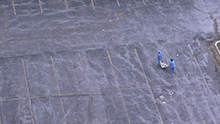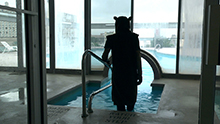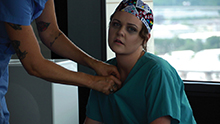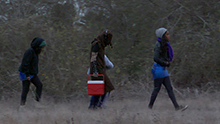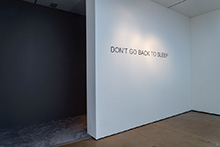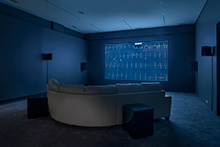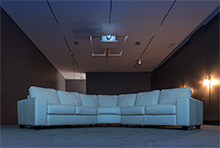BODY BAGS X Simulation training is part of both disaster preparedness and the education of warfighters. We act out scenarios of danger and destruction in order to understand how to react—that is, to act again—when they eventually occur. Almost ten years ago, I attended a simulation training expo at a convention center in Orlando, Florida. Each booth was staffed by a different corporation or research institute; in one, a West Coast company played a DVD on a monitor, depicting the war games they staged regularly in the California desert, inside a life-size mockup of an Iraqi village. The village was filled with actors playing civilians casualties, visions of collateral damage in the form of bloody men, women, and children, some appearing alive, others dead. One man, lying in the desert dirt, screamed as he held the red stump of his thigh, marking where most of his leg had been blown off. I asked the company spokesperson at the booth how they made his limb appear that way for the game. “Oh, he’s a veteran who lost his leg in combat,” he told me. “He works for us now.” X Stanya Kahn’s Don’t Go Back to Sleep (2014) begins with a distant overhead shot of a parking lot, bereft of cars. The camera zooms into the right half of the frame, picking out two doctors in blue scrubs as they carry the body of a third doctor, wrapped in a blanket, onto a grassy island beneath a light post. We recognize this kind of overhead shot, the God’s-eye shot. It began in the early 20th century as modernist tactic, in photos by Moholy-Nagy and Berenice Abbott, in films like Jean Vigo’s Zero pour conduit, as a means to distort everyday reality and make it strange, a way to renew our vision. But by the end of the century, this avant-garde technique had become the point of view of the aerial bomber, the police helicopter, the sniper, the drone. Once revolutionary, this shot is now the view of surveillance and control. It is the view of the law. It is the view from the top. X The world of Don’t Go Back to Sleep centers around a luxury housing development. Maybe condos. Everything appears new and not-dirty, in that suburban way. Plastic is still wrapped around parts of complex. Songbirds chirp, and the air is probably thick with phthalates. The inhabitants of this world are almost entirely doctors, like the ones we saw in the first moments of the film. They drink, and eat cupcakes. They talk on their phones. They dance to the Dazz Band's "Let it Whip" and Chic's "Le Freak" and James Brown's “Sex Machine.” They wander around the cut lawns and through the empty rooms. They are damaged and bandaged. They run from toxic clouds. They make out. They operate on one another. They fall and they die. Some sort of horrible event has occurred, and we are only witnessing the aftermath. A war, an epidemic, a zombie apocalypse. Now, the doctors are the only victims. The victims are the only doctors. The doctors care for the victims. The victims care for the doctors. X We reproduce the world in two ways: through simulations, and through reflections. Simulations are models of reality, created from the data that enters our eyes and ears and elsewhere. Drawing, writing, painting, sculpture, and in certain ways theater are all simulations, carefully constructed mock-ups of what we’ve experienced. Recordings are impressions of reality. Photographs are like this, and video footage, and audio recordings, and casts and handprints and x-rays. These are all images produced by powers outside our own minds, at some level beyond our control, seeing and hearing things that we haven’t. I think recordings are older than simulations. Language is a simulation, yes, but before we had cameras and tape decks to make recordings, we had mirrors, pools of water, shadows, and echoes. We had each other. Insofar as a movie is a simulation, we call it fiction. Insofar as it is a recording, we call it documentary. Because we can’t duplicate reality exactly (you know, that old map-and-the-territory problem), all reproductions are to some degree abstract. Certain elements of reality are retained, others discarded, in order to highlight particular aspects. If distortions enter the model, an abstraction might become monstrous, grotesque. X Two doctors stand at a counter, doing something with plastic water bottles filled with milk. Doctor 1: Everyone is a disgusting mess. X Two doctors watch two other doctors kiss; both are male-female pairs. The female kissing doctor has a bloody bandage around her neck. The male doctor looking at her says to his companion: that neck wound is looking a little leaky. X What does it mean to perform to the camera, and for the audience to therefore be absent, to be separated from you in both space and time? And what does it mean for that audience to receive that performance, when you aren’t really there anymore? It’s like writing a letter and sending it, except you write that letter with your whole body, with the way you move, the timbre of your voice, a subtle darting of your eye. Cameras are everywhere now, looking at us from the sides of buildings, blinking on the edge of our computer monitors, sitting in our pockets just waiting to be whipped out. We’ve gotten used to live video as a form of communication. Remember when “video telephones” seemed like an exciting, futuristic kinda thing? Try to keep that in mind the next time you rush home for another Skype meeting. You’ve mostly gotten used to this. But it’s always kind of awkward, addressing the camera when you’re trying to speak to a person. Recording your own image to show someone else is even stranger. You become self-conscious, trying to imagine the camera’s view of you. This is why acting can feel like an out-of-body experience, or something that inhabits you, a kind of spiritual possession. You must project yourself out of your body, and try to look down back upon yourself, imagining how you will be seen in the eyes of an as-yet-unrealized onlooker. But of course, this is impossible. We cannot leave our bodies. Only our reproductions can. X These liquids keep showing up in Don’t Go Back to Sleep: milk, water, alcohol, blood. X If you want to categorize Kahn’s videos, some are more like fictions, and some are more like documentaries. Most people would think of Kathy (2009) and Sandra (2009) as documentaries. In each of these videos, Kahn has conversations with another person. She edits the video so we see the other person, but not Kahn. In Kathy, this person is her best friend of many years; in Sandra, it’s Kahn’s gray-haired mother. Both of Kahn’s interlocutors speak of traumatic subjects. For Kathy, these events are in the past and present—she discusses familial dysfunction as well as job stress as a social worker while she is home recovering from a botched c-section. For Sandra, who recollects past struggles as a shipyard electrician and revolutionary, the central trauma is in the future, as she discusses with Kahn how she would like to be buried when she dies. Kahn’s It’s Cool, I’m Good (2010) is like a fiction happening inside a documentary. It is also extremely funny. Real funny, not “art funny.” Kahn, with bandages around her face and hands, seemingly improvises a running commentary about what might have happened to her. “It’s a really bad sunburn.” “I just got my head stuck in the pickle jar.” “This is just really bad herpes.” At points, she stumbles into the public view, sitting outside a restaurant, drinking through a straw. When someone asks her what happened, she makes up another story. “Surfing accident. Sharks, rocks. It was crazy.” The people speaking to her know she is watching them, but they cannot see her face. And they do not know they are being watched by the camera. Kahn is acting for the camera, but they are only acting for her. Most people would think of Don’t Go Back to Sleep as a fiction, albeit a strange one. Its story is highly elliptical, its premise unspoken, its characters unnamed. Kahn says the performers—all but one are non-professional actors—were strangers to her, their dialog largely improvised. The flow of the narrative, Kahn says, was shaped by these ongoing improvisations. This process of not-acting allowed them more room to appear as themselves, or, as Kahn offers, to inhabit a “new state in-between self and other.” X Performing is like speaking into a void. One must imagine the recipient of your message, think about how they will see and hear you. In the theater, an actor has a few response-expressions she can tune into: the live audience has its own ways of giving feedback, expressing varying intensities of pleasure and unpleasure. Like a drug, this live audience approval will cause a rush, and becomes painful when withdrawn. The performer for the camera does not have even this gratification. Perhaps she must imagine this too. Defer it, and take it in much more diffusely, through compliments, reviews, prizes, social media likes, and other emotional reinforcements, other crumbs of communication. X Jerry Lewis once wrote a book that includes his theory of comedy. He argues that all actors are like children. “Actors are a strange breed of people,” he says. “They are all nine years old. They stop at nine.” In this, he includes himself. "I am nine years old when performing comedy,” he writes. “At that age, hurt is possible, but degradation is seldom possible." You could look at actors another way, however. In acting, you truly become an adult. Because in order to act, you have to comprehend the contingency of life. You have to understand how it can be lived otherwise. You have to simulate the disasters that others have gone through, disasters different from your own. Ed Halter
|
